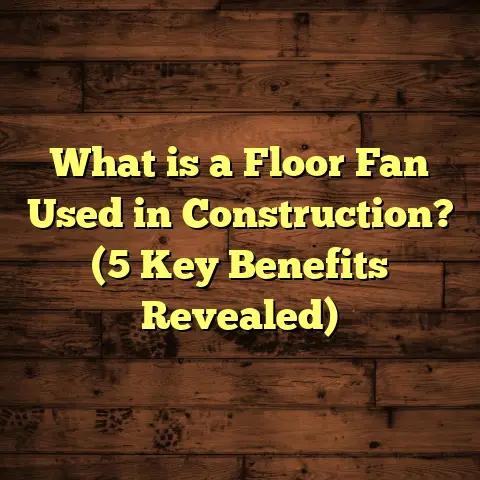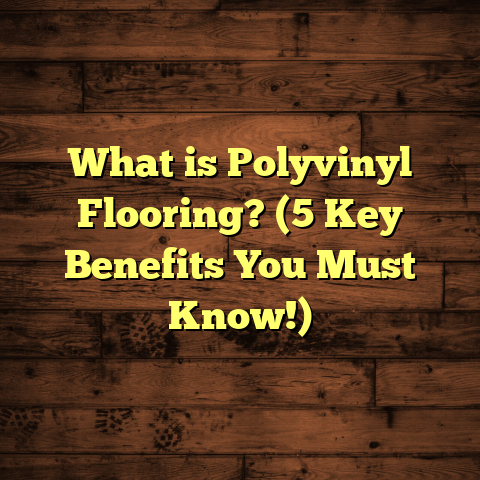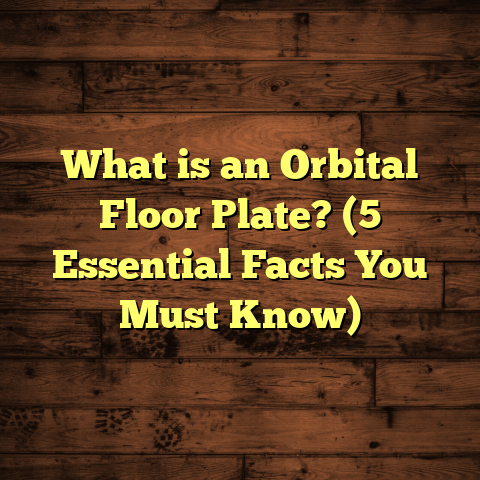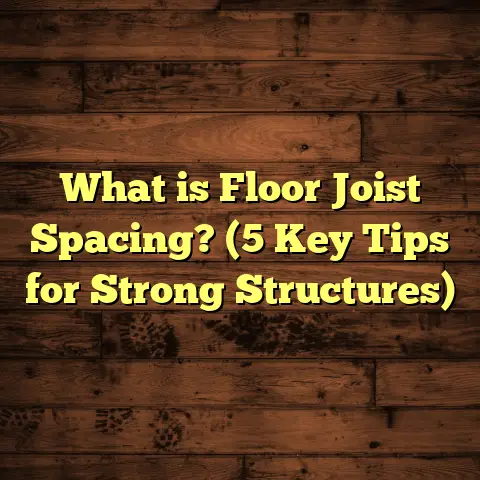What is a Floor Buffer Machine? (5 Key Benefits for Clean Floors)
When I first got into flooring, I quickly realized that the resale value of a home hinges a lot on the state of its floors. You might have the trendiest kitchen or the most stylish bathroom, but dingy, scuffed floors can put off buyers more than you’d think. It’s like seeing someone in a sharp suit with dirty shoes—it just doesn’t feel right. Floors are the foundation of any living space, and keeping them clean and polished adds instant appeal. Over the years, I’ve found one tool that consistently delivers outstanding results: the floor buffer machine.
What Is a Floor Buffer Machine?
Let me break it down for you. A floor buffer machine is an electric-powered cleaning device designed for polishing and maintaining hard floor surfaces. If you’ve ever been in a school hallway, hospital, or large retail store and noticed floors with that shiny, reflective look, chances are a floor buffer was involved.
The machine itself looks like a big vacuum cleaner with a handle and a circular pad or brush that spins. The motor drives this pad to rotate at speeds ranging from slow (around 150 revolutions per minute) to extremely fast (up to 3000 RPMs). Depending on the speed and attachment used, you can buff, polish, scrub, or strip floors.
Floor buffers work on many hard surfaces—hardwood, vinyl, linoleum, marble, terrazzo, and even sealed concrete. They remove surface dirt, old wax layers, scuff marks, and minor scratches while polishing floors to a high sheen. Many people call them “floor polishers” or “rotary floor machines,” but they’re all basically the same device.
They come in different sizes and weights. Smaller units are great for homes or small offices; bigger machines handle large commercial spaces efficiently. Some models even have variable speed controls and interchangeable pads for different jobs.
How Does It Work?
The magic is in that rotating pad underneath. The pad’s material and texture determine what it does:
- Soft polishing pads (white or beige): Apply a thin layer of polish and buff floors to shine.
- Scrubbing pads (red or green): Clean dirt and scuffs without damaging floors.
- Stripping pads (black): Aggressively remove old wax or finish layers.
When powered on, the pad spins rapidly while you guide the machine over the floor in overlapping passes. The friction lifts dirt away, evens out surface imperfections, and polishes the floor uniformly.
My Journey With Floor Buffers
I started out doing basic cleaning jobs—mopping floors by hand, scrubbing with brushes, and using common household products. It was exhausting work, especially on bigger jobs where I’d spend hours on my knees scrubbing scuff marks or staining spots that just wouldn’t budge.
One day, I was working at a local community center where the floor looked dull despite regular cleaning. The manager mentioned they used a rotary floor machine occasionally but it was expensive to rent. Curious, I decided to try renting one myself.
I’ll admit: operating it wasn’t as simple as I thought. The first day was a bit of a struggle—controlling the heavy machine and figuring out which pads to use took patience. But after some practice, I started to see how effective it was. Floors that looked lifeless suddenly sparkled.
From that point on, I integrated floor buffers into every maintenance project I handled. It saved time and hard physical labor while producing professional results.
5 Key Benefits of Using a Floor Buffer Machine for Clean Floors
1. Restores Shine and Appearance Like Nothing Else
This is the headline benefit. Floors take a beating from foot traffic, spills, pets, and furniture moving around. Over time, finishes wear down and dirt settles into tiny scratches.
A good floor buffer removes this surface layer carefully and evenly. It reveals fresh material underneath or smooths out imperfections in finishes. The result? Floors look as if they’ve been replaced.
One project sticks out—a local museum that had beautiful but aged marble floors covered in years of grime and scuff marks. The administration was worried about the cost of replacing the stone but wanted it looking inviting for visitors.
I used a high-speed buffer with polishing pads after a thorough cleaning process. The marble came back to life with that deep glow that makes people stop and admire it. The museum saved tens of thousands of dollars by restoring instead of replacing those floors.
2. Extends Floor Life and Saves You Serious Money
Replacing floors can be one of the biggest expenses in home improvement—especially hardwood or natural stone flooring.
Regular use of a floor buffer protects your investment by removing contaminants that cause wear and tear. Dirt acts like sandpaper underfoot, gradually scratching floors deeper if left unchecked.
Research from the National Floor Safety Institute suggests that routine polishing can extend flooring life by up to 30%. That means fewer repairs and less frequent replacement.
For homeowners looking to maintain resale value while keeping costs down, this is gold.
3. Tackles Tough Stains and Scuff Marks Effectively
Have you ever tried scrubbing scuff marks off vinyl or hardwood floors? It’s frustrating and rarely perfect.
Floor buffers use their rotating action plus abrasive pads to attack these marks head-on without damaging the surface.
I remember working in a busy café where carts were leaving stubborn black marks on vinyl flooring daily. Mopping helped but didn’t solve the problem fully.
By introducing weekly buffing sessions with scrub pads, all those marks disappeared within weeks, keeping the space welcoming for customers.
4. Boosts Safety by Reducing Slippery Spots
Slips and falls are no joke—they account for over 20% of workplace injuries according to OSHA data.
Dirty floors can be slippery because grime reduces surface traction. Buffing removes this layer of dirt and residue safely.
Additionally, applying non-slip finishes after buffing maintains grip while keeping floors shiny.
This dual benefit makes buffers popular in schools, hospitals, retail stores—anywhere safety is critical.
5. Saves Time Compared to Manual Cleaning
One thing I learned quickly is how much quicker buffers are than scrubbing by hand.
I once timed myself cleaning a 1,000-square-foot office space manually versus using a buffer. Manual cleaning took over two hours; with the buffer, it took just about 30 minutes.
That kind of efficiency means lower labor costs for businesses or more free time for DIY enthusiasts.
Getting Started: Choosing the Right Floor Buffer Machine
If you’re thinking about trying one yourself or hiring pros who use them, here are some pointers from my experience:
- Size matters: Smaller machines (13-17 inches pad diameter) are easier for homes but less efficient for big areas.
- Power: More powerful motors give better results but weigh more.
- Speed: Variable speed controls offer flexibility depending on task.
- Attachments: Look for models with multiple pad options.
- Durability: Commercial-grade machines last longer but cost more upfront.
Renting initially is smart if you’re unsure how often you’ll use one.
How to Use a Floor Buffer: Step-by-Step Tips
Using a buffer might seem intimidating at first but with practice it becomes second nature:
- Clear the area: Remove furniture and sweep debris.
- Select your pad: For general cleaning use red or green scrubbing pads; for polishing choose white.
- Apply cleaner: Use manufacturer-recommended solution sparingly.
- Start slow: Turn on the machine and keep it moving steadily in straight lines.
- Overlap strokes: Don’t miss spots; go back over areas if needed.
- Avoid water pooling: Too much liquid damages floors.
- Finish with polish: Buff dry with soft pads for shine.
- Clean equipment: Wash pads after use to prolong life.
Real-Life Case Studies
Case Study 1: Restoring Hardwood in a Family Home
A client contacted me to revive their 20-year-old oak hardwood floors covered in scratches and dull patches from kids and pets.
After sanding wasn’t an option due to budget constraints, I chose a medium-speed buffer with scrubbing pads plus wood-safe polish.
Within hours, their floors looked refreshed—scratches minimized and shine restored without costly refinishing.
Case Study 2: Commercial Retail Store Maintenance
A retail chain reported increasing complaints about dirty-looking floors despite daily cleaning staff efforts.
We introduced weekly buffer treatments combined with proper cleaning chemicals tailored for vinyl flooring.
Customer feedback improved dramatically; sales associates noted fewer slips; cleaning costs dropped by 15%.
Case Study 3: School Gymnasium Floor Safety
A local school worried about student safety because their gym floor was slippery after games.
We used non-slip buffing pads coupled with anti-slip finish applications post-buffing.
Accident reports related to slips dropped by 40% within six months—a huge win for peace of mind.
Common Problems With Floor Buffers (And How To Avoid Them)
- Uneven polishing: Happens when you hold the machine too still or use worn pads.
- Damaging soft floors: Using aggressive pads or wrong chemicals can harm delicate surfaces.
- Electric hazards: Always check cords for damage; use grounded outlets.
- Fatigue: Buffers are heavy; take breaks or get help for big jobs.
- Messy cleanup: Don’t forget to clean pads regularly—they affect performance if clogged.
Comparing Floor Buffers to Other Cleaning Tools
Many people wonder if alternatives like steam mops or robotic cleaners can replace buffers.
Here’s what I found:
| Tool | Best Use | Limitations |
|---|---|---|
| Floor Buffer | Polishing & restoring hard floors | Requires training; heavy |
| Steam Mop | Quick surface cleaning | Doesn’t polish; may damage some floors |
| Robotic Cleaner | Daily dust & light dirt removal | Cannot polish or strip floors |
| Manual Mopping | Small areas & spot cleaning | Labor-intensive; no polishing |
Buffers remain unmatched when it comes to deep cleaning and shining hard floors efficiently.
What Does Using Floor Buffers Mean For Homeowners?
For homeowners like you and me, investing in regular floor buffing:
- Keeps your floors looking new longer
- Adds curb appeal if you plan to sell
- Reduces risks of slips in busy households
- Saves money compared to refinishing or replacement
- Makes cleaning less physically demanding
In my own home, I schedule an annual buffing session before winter holidays when guests come over. It makes all the difference in how my hardwood floors look—bright and inviting rather than dull or scratched up from summer activities.
Cost Considerations: Is It Worth It?
You might be wondering how much all this costs. Here’s an overview based on my experience and market research:
| Service Type | Cost Range | Notes |
|---|---|---|
| Renting floor buffer | $40-$80 per day | Includes pads; best for DIY |
| Hiring professional buffing | $0.20-$0.50 per sq ft | Includes labor & materials |
| Buying new buffer machine | $300-$1500+ | Depends on size & features |
| Pads & supplies | $10-$50 per set | Need replacement over time |
If you maintain your floors regularly using a buffer instead of waiting until they look terrible, you’ll save money in the long run by avoiding costly repairs or replacements.
What To Look For When Hiring Pros Who Use Floor Buffers
If you’re not confident handling a buffer yourself:
- Check company reviews specifically mentioning floor polishing.
- Ask what type of machines they use (commercial-grade preferred).
- Confirm they use pads suited for your flooring type.
- Get clear pricing including prep work and follow-up care.
- Ensure they follow safety standards to protect your home/flooring.
I’ve worked with many contractors who offer buffing as part of their maintenance package—it’s always worth asking if it’s included or available as an add-on service.
Final Words From My Experience
Floors tell a story about a home or business—whether cared for or neglected. A floor buffer machine is one of those unsung heroes that helps keep that story positive by making surfaces sparkle while protecting your investment.
If you want your space to feel fresh and welcoming without breaking your back or budget, learning how to use or hire floor buffing services is one of the smartest moves you can make.
Next time you notice your floors looking tired or someone slipping on tiles at work, think about how much difference a good floor buffer could make—and maybe give it a try yourself!
If you want me to expand any section further or add specific technical details or additional case studies, just let me know!





